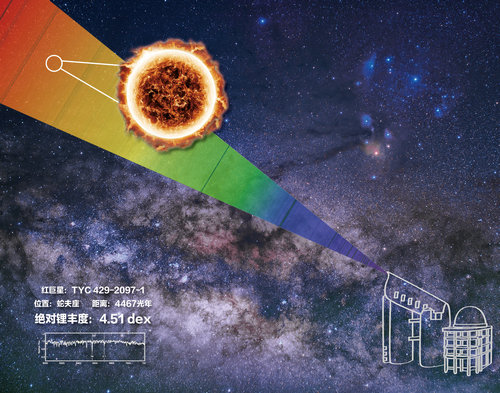

The international scientific journal Nature Astronomy released a significant discovery by Chinese astronomers on August 7. By using LAMOST, the scientific research team of the National Astronomical Observatories of the Chinese Academy of Sciences (CAS) found a star with more than 3000 times the amount of lithium found in similar celestial bodies; the fixed star actually has the highest abundance of lithium discovered so far.
Lithium is a key element that connects the Big Bang, interstellar matter and fixed stars. Its evolution in stars and the universe has always been an important topic in the field of astronomy. However, contemporary astronomy still has only limited understanding of lithium.
Giant stars where the element is abundant are rare, but when found they offer significant insight into lithium’s origin and evolution. Unfortunately, astronomers have found very few such objects in the past 30 years.
LAMOST’s capacity for spectral observation of massive stars is gradually being applied in basic astronomical research, and played an important role in this discovery.

An illustration of how LAMOST discovered a fixed star with the highest lithium abundance yet observed [Image from Chinese National Astronomy]
The fireball in the picture is the fixed star. It was found in the white circular area. The lower left shows the star’s light spectrum determined by LAMOST. The background is the galaxy near the fixed star.
The newly discovered Lithium-abundant star is located in the constellation Ophiuchus near the center of the Milky Way. It is north of the galactic disk, about 4500 light years from Earth.
Dr Yan Hongliang and researchers Zhao Gang and Shi Jianrong made this important discovery. They also cooperated with scientists from the China Institute of Atomic Energy Sciences and Beijing Normal University to further research the unique fixed star. They found that its lithium is likely to come from a special internal process of mass exchange. They analyzed the high resolution spectrum from an American Automated Planet Finder and the latest atomic data from the China Atomic Energy Research Institute to arrive at a reasonable explanation of the lithium abundance.
The discovery has doubled the observed limit of lithium content and changed human cognition of lithium in celestial bodies. Additionally, it presents a new and unique view of the role of lithium in existing theories of stellar evolution. The achievement is a frontier breakthrough in a basic discipline made by China’s large scientific equipment.
Source: National Astronomical Observatories of the Chinese Academy of Sciences (NAOC)